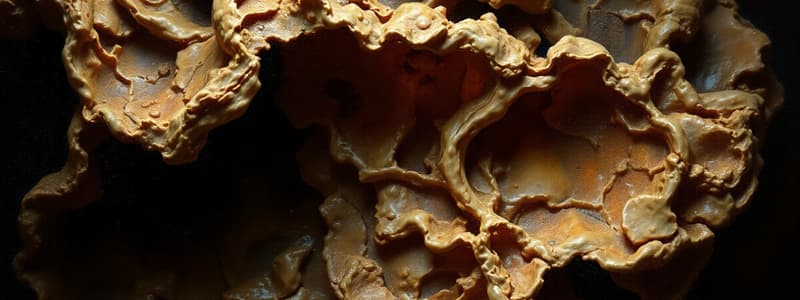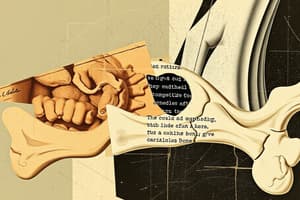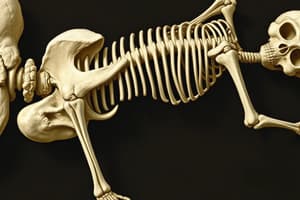Podcast
Questions and Answers
What is the primary inorganic component of the extracellular matrix in bone?
What is the primary inorganic component of the extracellular matrix in bone?
- Calcium salts (correct)
- Osteocalcin
- Proteoglycans
- Collagen fibers
Which cell type is responsible for bone formation?
Which cell type is responsible for bone formation?
- Osteoclasts
- Chondrocytes
- Osteocytes
- Osteoblasts (correct)
What is the main function of osteocytes in bone tissue?
What is the main function of osteocytes in bone tissue?
- Maintain the bone matrix (correct)
- Stimulate osteoclast activity
- Regulate calcium absorption
- Initiate bone formation
Which of the following best describes the organic matrix of bone?
Which of the following best describes the organic matrix of bone?
What role do osteoclasts play in bone tissue?
What role do osteoclasts play in bone tissue?
Which organic component is crucial for recruiting calcium ions in bone tissue?
Which organic component is crucial for recruiting calcium ions in bone tissue?
How does the absence of the organic matrix affect bone properties?
How does the absence of the organic matrix affect bone properties?
What are the small cavities where osteocytes reside called?
What are the small cavities where osteocytes reside called?
What is the primary structural unit of compact bone called?
What is the primary structural unit of compact bone called?
Which component of the osteon houses blood vessels and nerves?
Which component of the osteon houses blood vessels and nerves?
How do the collagen fibers in lamellae contribute to bone strength?
How do the collagen fibers in lamellae contribute to bone strength?
What is the role of canaliculi in the bone structure?
What is the role of canaliculi in the bone structure?
What describes the structure of spongy bone?
What describes the structure of spongy bone?
What initiates the intramembranous ossification process?
What initiates the intramembranous ossification process?
Which of the following bones typically form through intramembranous ossification?
Which of the following bones typically form through intramembranous ossification?
What characterizes trabeculae in spongy bone?
What characterizes trabeculae in spongy bone?
What primarily drives the process of bone deposition?
What primarily drives the process of bone deposition?
What is the main function of calcitonin in the body?
What is the main function of calcitonin in the body?
Which hormone acts to increase calcium levels in the blood?
Which hormone acts to increase calcium levels in the blood?
What occurs first in the process of bone repair after a fracture?
What occurs first in the process of bone repair after a fracture?
How does vitamin D contribute to bone health?
How does vitamin D contribute to bone health?
What type of cells are responsible for inhibiting bone resorption?
What type of cells are responsible for inhibiting bone resorption?
What condition can arise from a deficiency in vitamin D?
What condition can arise from a deficiency in vitamin D?
Which process occurs after soft callus formation during bone healing?
Which process occurs after soft callus formation during bone healing?
What is the primary role of osteoblasts during bone formation?
What is the primary role of osteoblasts during bone formation?
Which sequence correctly describes the initial steps of endochondral ossification?
Which sequence correctly describes the initial steps of endochondral ossification?
What happens to chondrocytes during the early stages of endochondral ossification?
What happens to chondrocytes during the early stages of endochondral ossification?
What structure is primarily formed by the osteoblasts surrounding the diaphysis of the cartilage model?
What structure is primarily formed by the osteoblasts surrounding the diaphysis of the cartilage model?
What is the significance of the periosteum in bone development?
What is the significance of the periosteum in bone development?
What does the term 'spongy bone' refer to in the context of bone structure?
What does the term 'spongy bone' refer to in the context of bone structure?
What remains of the cartilage model after the completion of ossification?
What remains of the cartilage model after the completion of ossification?
Which statement accurately reflects a key characteristic of endochondral ossification?
Which statement accurately reflects a key characteristic of endochondral ossification?
What type of bone is primarily formed through intramembranous ossification?
What type of bone is primarily formed through intramembranous ossification?
Which model is utilized during endochondral ossification?
Which model is utilized during endochondral ossification?
In which zone of the epiphyseal plate do chondrocytes enlarge and mature?
In which zone of the epiphyseal plate do chondrocytes enlarge and mature?
What process occurs at the outer surface of the bone during appositional growth?
What process occurs at the outer surface of the bone during appositional growth?
When does longitudinal growth of long bones typically cease?
When does longitudinal growth of long bones typically cease?
What is the first type of bone to form in intramembranous ossification?
What is the first type of bone to form in intramembranous ossification?
What happens to chondrocytes in the zone of calcification within the epiphyseal plate?
What happens to chondrocytes in the zone of calcification within the epiphyseal plate?
What type of bones are formed through endochondral ossification?
What type of bones are formed through endochondral ossification?
What is the primary function of appositional growth in bones?
What is the primary function of appositional growth in bones?
Which hormone directly promotes appositional growth in bones?
Which hormone directly promotes appositional growth in bones?
What role do osteoclasts play in bone remodeling?
What role do osteoclasts play in bone remodeling?
How does growth hormone (GH) influence longitudinal bone growth?
How does growth hormone (GH) influence longitudinal bone growth?
What occurs as a result of appositional growth in the bones?
What occurs as a result of appositional growth in the bones?
Which of the following factors does NOT influence appositional growth?
Which of the following factors does NOT influence appositional growth?
What is a potential consequence of excess growth hormone production after epiphyseal closure?
What is a potential consequence of excess growth hormone production after epiphyseal closure?
Which statement best describes bone resorption?
Which statement best describes bone resorption?
Flashcards
Bone Matrix Composition
Bone Matrix Composition
Bone is composed of 65% inorganic and 35% organic components.
Inorganic Bone Component
Inorganic Bone Component
Primarily calcium salts, especially hydroxyapatite crystals, giving bone strength and hardness.
Organic Bone Component
Organic Bone Component
Primarily collagen fibers (type I), giving bone flexibility and tensile strength. Also includes proteoglycans, glycoproteins, etc.
Osteoblasts Function
Osteoblasts Function
Signup and view all the flashcards
Osteocytes Function
Osteocytes Function
Signup and view all the flashcards
Osteoclasts Function
Osteoclasts Function
Signup and view all the flashcards
Bone Remodeling
Bone Remodeling
Signup and view all the flashcards
Bone Tissue Cell Types
Bone Tissue Cell Types
Signup and view all the flashcards
Osteon
Osteon
Signup and view all the flashcards
Lamellae
Lamellae
Signup and view all the flashcards
Haversian Canal
Haversian Canal
Signup and view all the flashcards
Lacunae
Lacunae
Signup and view all the flashcards
Canaliculi
Canaliculi
Signup and view all the flashcards
Trabeculae
Trabeculae
Signup and view all the flashcards
Intramembranous Ossification
Intramembranous Ossification
Signup and view all the flashcards
Endochondral Ossification
Endochondral Ossification
Signup and view all the flashcards
How do osteoblasts become osteocytes?
How do osteoblasts become osteocytes?
Signup and view all the flashcards
What is the role of trabeculae?
What is the role of trabeculae?
Signup and view all the flashcards
Periosteum
Periosteum
Signup and view all the flashcards
What is the bone collar?
What is the bone collar?
Signup and view all the flashcards
Medullary Cavity
Medullary Cavity
Signup and view all the flashcards
Longitudinal Growth
Longitudinal Growth
Signup and view all the flashcards
Zone of Reserve Cartilage
Zone of Reserve Cartilage
Signup and view all the flashcards
Zone of Proliferation
Zone of Proliferation
Signup and view all the flashcards
Zone of Hypertrophy
Zone of Hypertrophy
Signup and view all the flashcards
Zone of Calcification
Zone of Calcification
Signup and view all the flashcards
Appositional Growth
Appositional Growth
Signup and view all the flashcards
Appositional Growth: Outcome
Appositional Growth: Outcome
Signup and view all the flashcards
Appositional Growth: Duration
Appositional Growth: Duration
Signup and view all the flashcards
Growth Hormone (GH): Function
Growth Hormone (GH): Function
Signup and view all the flashcards
Testosterone and Bone Growth
Testosterone and Bone Growth
Signup and view all the flashcards
Bone Resorption
Bone Resorption
Signup and view all the flashcards
Bone Resorption: Outcome
Bone Resorption: Outcome
Signup and view all the flashcards
Bone Resorption: Importance
Bone Resorption: Importance
Signup and view all the flashcards
Bone Deposition
Bone Deposition
Signup and view all the flashcards
Calcitonin Role
Calcitonin Role
Signup and view all the flashcards
Parathyroid Hormone (PTH) Role
Parathyroid Hormone (PTH) Role
Signup and view all the flashcards
Vitamin D Role
Vitamin D Role
Signup and view all the flashcards
Hematoma Formation
Hematoma Formation
Signup and view all the flashcards
Soft Callus Formation
Soft Callus Formation
Signup and view all the flashcards
Bone Repair Steps
Bone Repair Steps
Signup and view all the flashcards
Study Notes
Inorganic Matrix
- Constitutes about 65% of bone weight
- Primarily calcium salts (hydroxyapatite)
- Other minerals present: phosphorus, bicarbonate, potassium, magnesium, and sodium salts
- Provides hardness and strength to bone, crucial for compressive forces
Organic Matrix
- Constitutes about 35% of bone weight
- Primarily collagen fibers (type I) providing tensile strength and flexibility
- Contains: proteoglycans, glycosaminoglycans, glycoproteins, and bone-specific proteins (e.g., osteocalcin)
- Proteins and proteoglycans recruit calcium and bind matrix components
- Collagen resists twisting and tensile forces
- Essential for bone strength; brittle if organic matrix removed; flexible if inorganic matrix lacking
Functions of the Three Main Cell Types in Bone Tissue
1. Osteoblasts
- Function: Bone formation
- Synthesize and secrete organic components of bone matrix (osteoid) and mineralize
- Location: Inner periosteum and endosteum
2. Osteocytes
- Function: Maintain bone matrix, regulate mineral content, and communicate with other bone cells
- Respond to mechanical stress
- Location: Small cavities called lacunae, surrounded by bone matrix
3. Osteoclasts
- Function: Bone resorption
- Break down bone tissue by secreting hydrogen ions and enzymes
- Crucial for bone remodeling and calcium homeostasis
- Location: Depressions called Howship's lacunae; originate from mononuclear precursors in the bone marrow
Microscopic Structure of Compact Bone and Osteons
- Compact Bone: Organized into structural units (osteons) which are cylindrical and run parallel to the long axis of the bone
- Osteon: Each consists of concentric layers (lamellae) surrounding a central canal (Haversian canal), which contains blood vessels and nerves
- Collagen fibers within adjacent lamellae have alternating orientations, resisting torsional forces
Components of the Osteon
- Central Canal: Contains blood vessels and nerves
- Lamellae: Layers of bone matrix, concentrically arranged, enhancing strength
- Lacunae: Small cavities in lamellae housing osteocytes
- Canaliculi: Tiny channels connecting lacunae, facilitating nutrient and waste exchange between osteocytes and blood vessels
Spongy Bone
- Composed of a network of interconnecting trabeculae (branches of bone)
- Porous structure, lighter than compact bone
- Trabeculae support and house marrow but do not contain osteons
- Similar lamellae organization, but parallel or irregular
- Osteocytes reside in lacunae within the trabeculae, connected by canaliculi to receive nutrients from the surrounding bone marrow
Studying That Suits You
Use AI to generate personalized quizzes and flashcards to suit your learning preferences.




